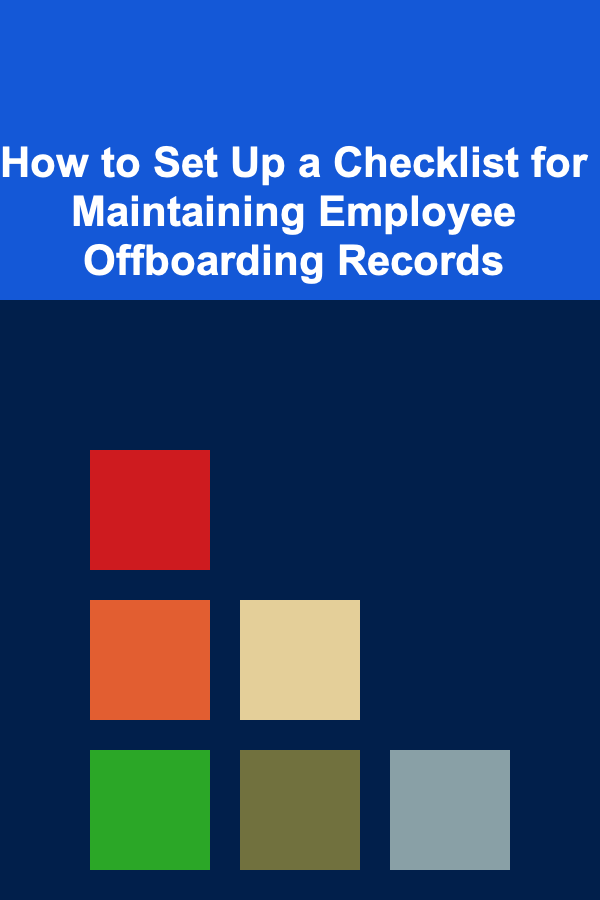
How to Set Up a Checklist for Maintaining Employee Offboarding Records
ebook include PDF & Audio bundle (Micro Guide)
$12.99$6.99
Limited Time Offer! Order within the next:

Employee offboarding is a critical process in any organization, ensuring that both the employee and the company part ways smoothly. A well-structured offboarding procedure helps organizations maintain compliance, safeguard sensitive information, and ensure a smooth transition for both the departing employee and the team that remains. One of the key elements of effective offboarding is maintaining thorough records. These records help track the offboarding process, ensure that all required tasks are completed, and prevent any potential issues down the line.
In this guide, we will delve into how to set up a comprehensive checklist for maintaining employee offboarding records, covering everything from legal requirements to asset management. By following these steps, you can streamline your offboarding process and ensure that all necessary documentation is in place for future reference.
Understand the Purpose of Offboarding Records
Before diving into the specifics of setting up a checklist, it's essential to understand why maintaining employee offboarding records is crucial. These records serve several key purposes:
- Legal Compliance: In some cases, laws require employers to maintain records of employee termination, whether voluntary or involuntary. This is particularly important when dealing with tax documentation, unemployment claims, or disputes related to employment.
- Protecting Sensitive Information: During offboarding, employees often have access to sensitive company data. Maintaining records ensures that all data is returned and that access to confidential systems is revoked.
- Operational Continuity: A comprehensive record helps to ensure that any ongoing projects, knowledge, or responsibilities are properly transitioned to other team members, ensuring minimal disruption to the organization.
- Future Reference: Offboarding records also serve as a valuable reference in case of future audits, potential rehire opportunities, or if there are any disputes that arise after the employee leaves.
With this in mind, let's take a closer look at how to establish a detailed checklist for employee offboarding records.
Key Elements of an Employee Offboarding Checklist
An offboarding checklist should cover all essential aspects of the employee's departure. This includes everything from administrative tasks to the return of company property. Below are the key elements that should be incorporated into your checklist to ensure that no details are overlooked.
1. Legal and Administrative Documents
One of the first steps in the offboarding process is ensuring that all legal and administrative paperwork is completed. These documents serve as the foundation for the entire process and should be properly filed for future reference.
- Final Paycheck: Ensure the employee receives their final paycheck, including any unused vacation or sick leave, overtime pay, or severance packages, in compliance with local labor laws.
- Severance Agreement (if applicable): If the employee is entitled to severance, ensure the severance agreement is signed and filed.
- Non-Disclosure and Non-Compete Agreements: Review any outstanding non-disclosure or non-compete agreements and ensure the employee understands their obligations post-employment.
- Exit Interview Documentation: Schedule an exit interview to understand the employee's experience within the company, identify areas of improvement, and collect feedback. Document the responses and store the interview notes.
- Termination/Resignation Letter: Keep a copy of the resignation letter or termination notice for your records.
2. Data Access and Security
Employees often have access to sensitive company data, systems, and tools. It is critical to ensure that all access is revoked and that no data is left behind.
- Revoking Access to Company Systems: Ensure that the employee's login credentials are disabled for all company systems, email accounts, and software tools. This includes both on-premises and cloud-based systems.
- Return of Digital Assets: Verify the return of any digital assets, including laptops, external hard drives, mobile phones, or any other devices provided by the company. Make sure to back up any files that need to be transferred.
- Change of Account Credentials: If the employee had access to shared accounts or systems, change the passwords and notify the relevant teams about the change.
- Data Transfer: Ensure all relevant documents, emails, and files owned by the employee are transferred to the appropriate person or team before access is revoked.
3. Return of Company Property
Employees often take company property with them when they leave. To ensure the company isn't left short, it's important to document the return of any physical assets.
- Company ID, Keys, and Access Cards: Ensure the employee returns any identification badges, building access cards, office keys, or security cards.
- Company Credit Cards: If the employee had a company-issued credit card, ensure it is returned, and all transactions are accounted for.
- Uniforms or Equipment: If applicable, ensure the return of uniforms, equipment, or any specialized tools or gear issued by the company.
- Office Supplies: Verify the return of any office supplies or items loaned to the employee, such as company-provided books or training materials.
4. Knowledge Transfer
Knowledge transfer is one of the most important elements of offboarding, ensuring that the departing employee's duties and knowledge are passed on to others in the team. Proper documentation and communication are essential.
- Transition Plan: Create a detailed transition plan outlining key responsibilities, ongoing projects, and any outstanding tasks. Ensure this plan is shared with the employee's successor or manager.
- Documenting Work: Have the employee document any processes, procedures, or relevant information to make it easier for the next person to take over.
- Handover Meetings: Schedule handover meetings with the employee to walk through ongoing projects, explain key processes, and answer any questions the replacement might have.
- Project Updates: Ensure all active projects are up to date and that relevant stakeholders are informed of the changes.
5. Final Employee Benefits and HR Records
Depending on the employee's position and tenure, several benefits and HR records must be addressed before their departure.
- Benefits Termination: Provide the employee with information about the termination of benefits, such as health insurance, retirement plans, or stock options. Ensure they know how to access COBRA or other continuation benefits if applicable.
- Pension or Retirement Plans: If the employee has a pension or retirement plan, provide them with instructions on how to access or transfer their accounts.
- Tax Documentation: Provide the employee with any necessary tax forms, such as their final W-2 or 1099 forms, and explain how to access future tax documents if needed.
- Employee Feedback and Exit Survey: If applicable, collect feedback through an exit survey. This feedback can be helpful for improving the company's work environment and addressing any systemic issues.
6. Communication and Internal Documentation
Clear communication is key to a smooth offboarding process. Ensure that the appropriate internal stakeholders are informed about the employee's departure.
- Notifying Relevant Teams: Inform the relevant departments (HR, IT, finance, etc.) about the employee's departure so they can take action as needed.
- Internal Announcement: If the employee was in a visible position within the company, consider crafting a formal announcement to inform the team and any external partners or clients of their departure.
- Record Maintenance: Store all documents related to the employee's offboarding process in a secure, centralized location. This may include paper files or digital records.
7. Post-Offboarding Checklist
Even after the employee has left, certain actions may be necessary to complete the offboarding process.
- Final Tax Filings: Ensure that any tax-related filings are completed promptly and accurately, and retain a copy of these for future reference.
- Audit of Company Systems: Conduct a security audit to verify that no sensitive information or company property was left behind.
- Rehire Status: Maintain records related to the employee's eligibility for rehire, in case they wish to return to the company in the future.
- Legal Compliance and Retention: Store all offboarding records in compliance with local labor laws, which may include retaining certain documents for a specified period.
Implementing the Checklist
Once the checklist has been outlined, it's time to put it into practice. Here are some steps to ensure your checklist is implemented efficiently:
- Create a Digital or Physical Template: Make the checklist accessible to all HR team members, managers, and IT personnel by creating a shared digital template or physical document.
- Automate Where Possible: Use HR software or offboarding tools to automate reminders, document collection, and other administrative tasks. Automation helps ensure that no step is overlooked.
- Train HR and Management Teams: Regularly train HR personnel and managers on the offboarding process, ensuring they understand their responsibilities and the importance of maintaining accurate records.
- Monitor and Improve: Continuously monitor the offboarding process for areas of improvement. Collect feedback from departing employees, managers, and other teams to refine the checklist and make the process more efficient.
Conclusion
Maintaining employee offboarding records is an essential part of the offboarding process, providing legal protection, ensuring knowledge transfer, and safeguarding company assets. By developing a comprehensive checklist, you can ensure that all tasks are completed systematically and nothing is overlooked. This not only reduces risk but also provides valuable insight for improving your company's offboarding experience for future employees.
Reading More From Our Other Websites
- [Organization Tip 101] How to Create a Vision Board in Your Study Space
- [Skydiving Tip 101] From Ground to Freefall: A Step‑by‑Step Guide to Your First Skydiving Jump
- [Small Business 101] Small Business Internet Provider: How to Improve Connectivity for Your Team
- [Home Storage Solution 101] How to Use Bookshelves to Store Seasonal Items and Maximize Space
- [Home Family Activity 101] How to Plan an Indoor Mini Olympics for Family Fun
- [Home Storage Solution 101] How to Use Clear Storage Containers for Easy Organization
- [Organization Tip 101] How to Use Drawer Organizers for Essential Oil Storage
- [Home Space Saving 101] How to Save Space in the Kitchen with Clever Storage Solutions
- [Organization Tip 101] How to Make Your Library Kid-Friendly and Engaging
- [Home Renovating 101] How to Create a Functional Home Office During Your Renovation

How to Keep Furniture Organized in a Shared Space
Read More
How to Manage Your Pet's Weight for Long-Term Health
Read More
How to Optimize Your Amazon Listings for Designed Products: An Actionable Guide
Read More
How to Use Baskets for Stylish and Functional Storage
Read More
How to Develop a Winning Baseball Team Culture
Read More
How to Optimize Supply Chain Operations
Read MoreOther Products

How to Keep Furniture Organized in a Shared Space
Read More
How to Manage Your Pet's Weight for Long-Term Health
Read More
How to Optimize Your Amazon Listings for Designed Products: An Actionable Guide
Read More
How to Use Baskets for Stylish and Functional Storage
Read More
How to Develop a Winning Baseball Team Culture
Read More